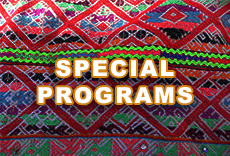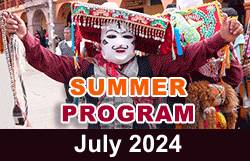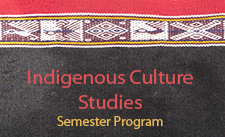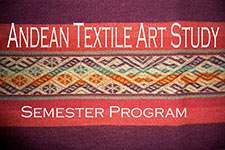ONLINE COURSE – SEMIOLOGY OF THE ANDEAN TEXTILES
Textiles as an information recording system
In their millenary existence, Andean societies have developed ways of conceptualizing the relationships of humans and nature. Textiles were one of the recording tools used by complex pre-Hispanic Andean civilizations to store the science developed at that time.
Precisely the contemporary textiles, made at the high-Andean communities, preserve that understanding of the world. Therefore, as we were trained in the use and understanding of alphabetic linear writing, we will learn how to understand the symbolic textile language from an anthropological approach considering the context of its use.
For more information and costs contact us here |
WEAVING LESSONS WITH THE BACKSTRAP LOOM
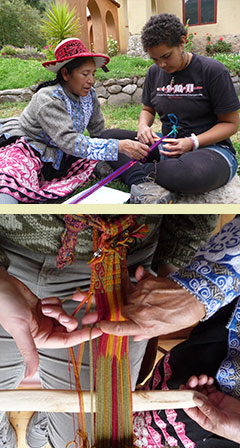 This module’s approach consists in getting trained in the weaving technique, from a simple panel (pampa), on to lineal combinations (lista, t’ullu/patapata), all the way to complex figurative geometrical compositions and abstract expressions. The textile pieces to be woven vary, from ribbons, on to chuspas, to get to large pieces: This module’s approach consists in getting trained in the weaving technique, from a simple panel (pampa), on to lineal combinations (lista, t’ullu/patapata), all the way to complex figurative geometrical compositions and abstract expressions. The textile pieces to be woven vary, from ribbons, on to chuspas, to get to large pieces:
- Learning how to spin: Preparation of the wool and training in handling the spindle (puska).
- Learning how to twist the threads (k’antiy) is essential for the weaving process.
- Training in the handling of the loom’s tools: Khallwa and wich’una.
- Preparation of the looms and their variations, according to combinations of icons, as well as the preparation and incorporation of their additional systems: Illawa (System which has a levering function, together with that of separating the threads from the weft) and mini (Weft thread).
- Training in the handling of the mini and illawa.
- Training in the pick-up technique (pallay).
The teaching process is gradual and individualized, according to each participant’s experience and goals. |
ICONOGRAPHY, SIGNS AND WRITING
WHAT ANDEAN TEXTILES TELL US
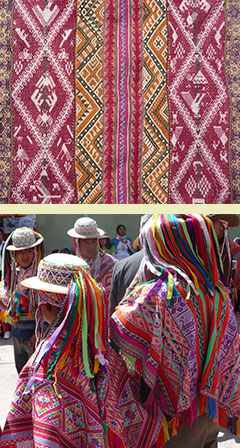 Historically speaking, we know that textiles served as key information transmission documents. Today, apart from their functional use, the diversity of pieces still remains an informative depositary paradigm, in such a way that, to get dressed in a piece of woven fabric, is like “wrapping” oneself up in a social skin of images and icons with complex meaning. Historically speaking, we know that textiles served as key information transmission documents. Today, apart from their functional use, the diversity of pieces still remains an informative depositary paradigm, in such a way that, to get dressed in a piece of woven fabric, is like “wrapping” oneself up in a social skin of images and icons with complex meaning.
- Textile art as an information panel: As a matter of fact, decoding the iconography, we will see that fabrics convey complex information about social memories, such as cosmology, astronomy, religion, myths and history.
- Textile clothing, as a heritage from the divinities and ancestors: The ethnographic information and analysis of mythic cycles will show us the conception of the ‘costume, dress or clothing’, from the indigenous perspective.
- Rites, offerings, divinities and animism: Woven fabrics play a very important role in religious practices, and possess a sacral category, in addition of being animated entities. Likewise, we’ll take a look at their relationship with agriculture, the growing of plants and their function as connectors, between the world of the living and that of the ancestors.
- Conception of time, whether linear, circular or cyclical: The Master Weavers inlay icons in their works that illustrate concepts of time and eschatology (Pachakuti or Cosmic Cataclysm).
|
NATURAL DYEING WORKSHOPS
NATURE’S COLORS AND ANCESTRAL KNOWLEDGE
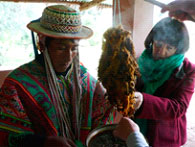 The archaeological textile pieces show the excellent achievement reached by the pre-Hispanic Andean civilizations, in the science of dyeing. Nowadays, this knowledge is applied by Master Weavers, throughout the Andes. In our workshops, our participants learn: The archaeological textile pieces show the excellent achievement reached by the pre-Hispanic Andean civilizations, in the science of dyeing. Nowadays, this knowledge is applied by Master Weavers, throughout the Andes. In our workshops, our participants learn:
- The predisposition of the thread balls to be dyed.
- The threads’ degreasing process, for correct dyeing: We will use natural ammonias and alkaline modifiers, for an efficient degreasing and whitening process.
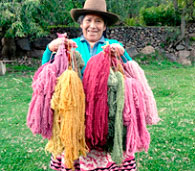 The “mordentado” process: In order to ensure the dye’s setting, we will use natural products that contain alumina and potassium sulfates which, not only have a setting function, but, also, that of influencing the colors’ intensity. The “mordentado” process: In order to ensure the dye’s setting, we will use natural products that contain alumina and potassium sulfates which, not only have a setting function, but, also, that of influencing the colors’ intensity.- The dyeing activity: We will use leaves, seeds, flowers and roots from different wild plants, in general, together with cochineal (Cactus fleas).
The workshops are led by specialists, at our Center. |
LEARN TO KNIT ANDEAN-STYLE!
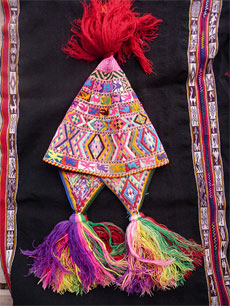 The knitting technique dates back from pre-Colombian times. Thus, we can see a diversity of archaeological samples, such as those proceeding from the Huari culture (600-900 a.D.). Nowadays, this technique is very much used by textile Masters, to produce a variety of articles of daily use; the weaving of chullos being one of the most popular ones. The knitting technique dates back from pre-Colombian times. Thus, we can see a diversity of archaeological samples, such as those proceeding from the Huari culture (600-900 a.D.). Nowadays, this technique is very much used by textile Masters, to produce a variety of articles of daily use; the weaving of chullos being one of the most popular ones.
This course consists in that technique’s gradual learning, taught by our Master Weavers.
Aspects of the program’s content:
- Thread twisting technique.
- Preparation of the points and point chains colors, to give shape to the base of the article to be woven.
- The handling of the small sticks that vary, according to the hues of colors and designs applied.
- The procedure of the picas, and training in their respective technique.
- Types of finishes and embellishments: The difficulty level will be adapted to the student’s level and predisposition.
CHULLO KNITTING LESSONS
Knit your own chullo, using the Andean knitting technique!
 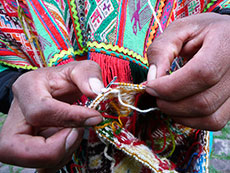 The chullo, woven with the knitting technique, is one of the Andean culture’s most distinguished products, as it even possesses a sacred value. In this program, the participant will learn the technique, so as to knit a chullo, in a gradual manner, as well as to develop iconographies that consist in geometrical and plant-like stylizations, as well as abstractions of birds, mammals, etc. The chullo, woven with the knitting technique, is one of the Andean culture’s most distinguished products, as it even possesses a sacred value. In this program, the participant will learn the technique, so as to knit a chullo, in a gradual manner, as well as to develop iconographies that consist in geometrical and plant-like stylizations, as well as abstractions of birds, mammals, etc.
The application of diverse types of finishes is part of the program, like in the case of the pointed finishes’ technique which even has a cosmological implication.
The chullo as an information panel
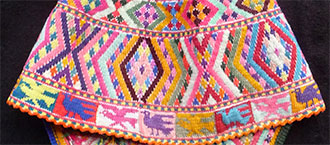 In fact, the participants will discover how the chullo, apart from being a garment, is an information panel. Indeed, as we decode its symbols, texture and structure, we will have access to astronomical, religious, philosophical and cosmological information, in the Andean society. In fact, the participants will discover how the chullo, apart from being a garment, is an information panel. Indeed, as we decode its symbols, texture and structure, we will have access to astronomical, religious, philosophical and cosmological information, in the Andean society.
|
KHARKA OR K´UPA TECHNIQUE LESSONS
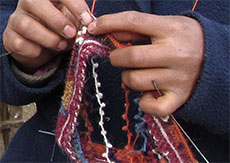 This is a variation of the point technique, which consists in knots and ties. It was a technique used in pre-Colombian cultures and, especially, in the Huari culture (600-900 a.D.). Nowadays, using that technique, purses, chullos and small bags are woven. This is a variation of the point technique, which consists in knots and ties. It was a technique used in pre-Colombian cultures and, especially, in the Huari culture (600-900 a.D.). Nowadays, using that technique, purses, chullos and small bags are woven.
In this program, participants learn how to weave their own articles which they have chosen. Gradually, they will develop geometrical, abstract and figurative iconographies. |
HISTORY OF ANDEAN TEXTILE ART
PRE-HISPANIC TIME PERIOD (PRE-INCA AND INCA), UP TO PRESENT DAYS
 “The (textile) styles cannot be comprehended, without knowing the historical context which produces them, as well as the religious world and temporal space they express.” (T. Gisbert) “The (textile) styles cannot be comprehended, without knowing the historical context which produces them, as well as the religious world and temporal space they express.” (T. Gisbert)
The development of textile confection had a singular importance for the pre-Hispanic Andean societies which managed to reach truly admirable levels of technical skills and artistic expression. We will examine the pre-Incan world of textile art and, especially, that of the Paracas, Huari, Chancay and Tiawanaku civilizations. Then, we’ll focus on textile art, in its different aspects. The variety of fabrics, clothes and techniques, actually produced in the Andes, will be part of the program.
- The textiles’ role in the pre-Hispanic societies: Textiles for sacrifices and offerings, as well as for the religious elite and gods. The function of textiles, in social and political contexts, is part of the theme, as well.
- Huari abstractions and modern art: A comparative analysis.
- Decoding of the Incan kings’ clothing: The iconography, visible on the Incan elite’s clothes (tocapus), had the function of a non-alphabetical writing, similar to ancient China’s. The Incan textile art schools are part of the course’s contents, as well.
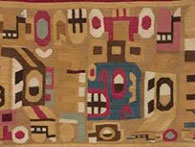 The qhipus were the Incas’ “computers”, with a system of knots, to store information: The qhipus constitute a system based on knots, the logics of which are binary and similar to that of modern computer science. They were used for the immense Incan State’s administration. There were several types of qhipus, with specific functions. The qhipus were the Incas’ “computers”, with a system of knots, to store information: The qhipus constitute a system based on knots, the logics of which are binary and similar to that of modern computer science. They were used for the immense Incan State’s administration. There were several types of qhipus, with specific functions.- Techniques, iconographies and costumes, in present days: Each ethnic nation has its own clothing, as well as its textiles’ designs and structures. However, in the midst of that huge variety, there are shared patterns that unify them. We will explore their criteria, styles and varieties.
|
STAY AT AN INDIGENOUS COMMUNITY
WEAVE IN THE TRADITION’S CRADLE
Cultural immersion and intercultural experience
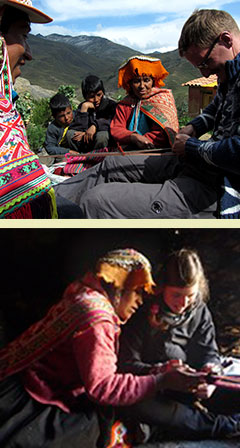 The High Andean communities are depositaries of the ancestral knowledge. Their social, cultural and political models are pre-Hispanic, in their origin and, currently, they cohabitate with schemes and realities proceeding from the official system in place, and globalization. Nevertheless, these communities are the cradle of our textile tradition. The High Andean communities are depositaries of the ancestral knowledge. Their social, cultural and political models are pre-Hispanic, in their origin and, currently, they cohabitate with schemes and realities proceeding from the official system in place, and globalization. Nevertheless, these communities are the cradle of our textile tradition.
Staying in an indigenous community is a unique and much recommended intercultural experience, because, there, you will be able to:
- Receive lessons from the community’s best weavers.
- Have on site live experience of their traditional way of life, as well as of the regulating patterns that correspond to a non-monetary system, such as reciprocity, for example, which is one of communal cohabitation’s main regulating principles.
- Have a live experience of social and ecological parameters practiced by Andean societies: The integration and assimilation capacity, when facing exogenous elements, concepts of ecology and cohabitation with nature, based on reciprocity, etc.
- Enjoy nature, pure air and peacefulness, far from the urban world and pollution.
We work with the communities of Canchacancha and Accha Alta, and our participants are lodged by families of those communities. |





 This module’s approach consists in getting trained in the weaving technique, from a simple panel (pampa), on to lineal combinations (lista, t’ullu/patapata), all the way to complex figurative geometrical compositions and abstract expressions. The textile pieces to be woven vary, from ribbons, on to chuspas, to get to large pieces:
This module’s approach consists in getting trained in the weaving technique, from a simple panel (pampa), on to lineal combinations (lista, t’ullu/patapata), all the way to complex figurative geometrical compositions and abstract expressions. The textile pieces to be woven vary, from ribbons, on to chuspas, to get to large pieces: Historically speaking, we know that textiles served as key information transmission documents. Today, apart from their functional use, the diversity of pieces still remains an informative depositary paradigm, in such a way that, to get dressed in a piece of woven fabric, is like “wrapping” oneself up in a social skin of images and icons with complex meaning.
Historically speaking, we know that textiles served as key information transmission documents. Today, apart from their functional use, the diversity of pieces still remains an informative depositary paradigm, in such a way that, to get dressed in a piece of woven fabric, is like “wrapping” oneself up in a social skin of images and icons with complex meaning. The archaeological textile pieces show the excellent achievement reached by the pre-Hispanic Andean civilizations, in the science of dyeing. Nowadays, this knowledge is applied by Master Weavers, throughout the Andes. In our workshops, our participants learn:
The archaeological textile pieces show the excellent achievement reached by the pre-Hispanic Andean civilizations, in the science of dyeing. Nowadays, this knowledge is applied by Master Weavers, throughout the Andes. In our workshops, our participants learn: The “mordentado” process: In order to ensure the dye’s setting, we will use natural products that contain alumina and potassium sulfates which, not only have a setting function, but, also, that of influencing the colors’ intensity.
The “mordentado” process: In order to ensure the dye’s setting, we will use natural products that contain alumina and potassium sulfates which, not only have a setting function, but, also, that of influencing the colors’ intensity. The knitting technique dates back from pre-Colombian times. Thus, we can see a diversity of archaeological samples, such as those proceeding from the Huari culture (600-900 a.D.). Nowadays, this technique is very much used by textile Masters, to produce a variety of articles of daily use; the weaving of chullos being one of the most popular ones.
The knitting technique dates back from pre-Colombian times. Thus, we can see a diversity of archaeological samples, such as those proceeding from the Huari culture (600-900 a.D.). Nowadays, this technique is very much used by textile Masters, to produce a variety of articles of daily use; the weaving of chullos being one of the most popular ones.
 The chullo, woven with the knitting technique, is one of the Andean culture’s most distinguished products, as it even possesses a sacred value. In this program, the participant will learn the technique, so as to knit a chullo, in a gradual manner, as well as to develop iconographies that consist in geometrical and plant-like stylizations, as well as abstractions of birds, mammals, etc.
The chullo, woven with the knitting technique, is one of the Andean culture’s most distinguished products, as it even possesses a sacred value. In this program, the participant will learn the technique, so as to knit a chullo, in a gradual manner, as well as to develop iconographies that consist in geometrical and plant-like stylizations, as well as abstractions of birds, mammals, etc. In fact, the participants will discover how the chullo, apart from being a garment, is an information panel. Indeed, as we decode its symbols, texture and structure, we will have access to astronomical, religious, philosophical and cosmological information, in the Andean society.
In fact, the participants will discover how the chullo, apart from being a garment, is an information panel. Indeed, as we decode its symbols, texture and structure, we will have access to astronomical, religious, philosophical and cosmological information, in the Andean society. This is a variation of the point technique, which consists in knots and ties. It was a technique used in pre-Colombian cultures and, especially, in the Huari culture (600-900 a.D.). Nowadays, using that technique, purses, chullos and small bags are woven.
This is a variation of the point technique, which consists in knots and ties. It was a technique used in pre-Colombian cultures and, especially, in the Huari culture (600-900 a.D.). Nowadays, using that technique, purses, chullos and small bags are woven. “The (textile) styles cannot be comprehended, without knowing the historical context which produces them, as well as the religious world and temporal space they express.” (T. Gisbert)
“The (textile) styles cannot be comprehended, without knowing the historical context which produces them, as well as the religious world and temporal space they express.” (T. Gisbert) The qhipus were the Incas’ “computers”, with a system of knots, to store information: The qhipus constitute a system based on knots, the logics of which are binary and similar to that of modern computer science. They were used for the immense Incan State’s administration. There were several types of qhipus, with specific functions.
The qhipus were the Incas’ “computers”, with a system of knots, to store information: The qhipus constitute a system based on knots, the logics of which are binary and similar to that of modern computer science. They were used for the immense Incan State’s administration. There were several types of qhipus, with specific functions. The High Andean communities are depositaries of the ancestral knowledge. Their social, cultural and political models are pre-Hispanic, in their origin and, currently, they cohabitate with schemes and realities proceeding from the official system in place, and globalization. Nevertheless, these communities are the cradle of our textile tradition.
The High Andean communities are depositaries of the ancestral knowledge. Their social, cultural and political models are pre-Hispanic, in their origin and, currently, they cohabitate with schemes and realities proceeding from the official system in place, and globalization. Nevertheless, these communities are the cradle of our textile tradition.